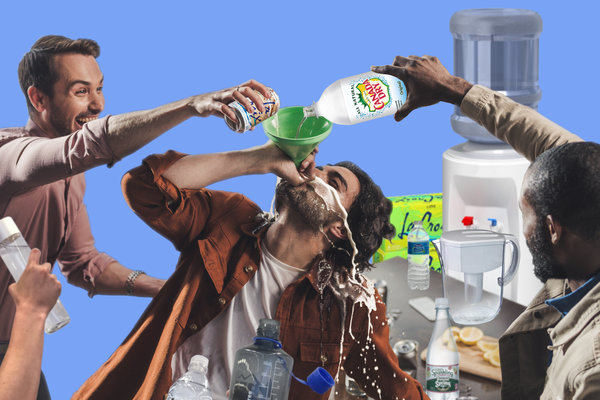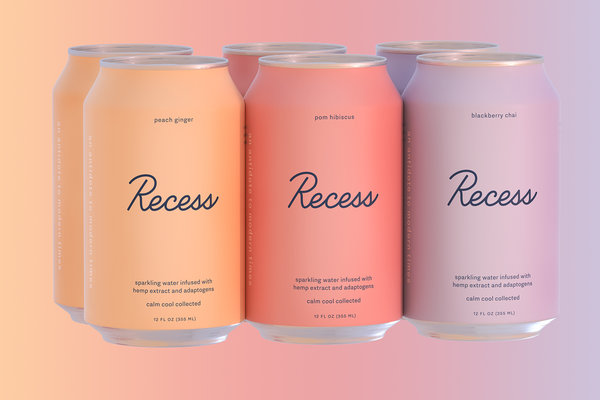Trent Mooring was tired of mixing drinks. At beach gatherings and garden parties, Mr. Mooring, the president of Mother Earth Brewing in Kinston, N.C., was stuck on cocktail duty for his wife and sisters-in-law, who don’t care for his craft brewery’s pilsners and I.P.A.s.
Last year, his wife, Caroline, started buying alcoholic seltzers as convenient stand-ins for her favorite gin and tonic. The growing popularity of hard seltzer — a fizzy, low-calorie alcoholic beverage typically made by fermenting sugar — piqued his interest. People were excited about a 5 percent A.B.V. (alcohol by volume) drink that “tasted just like LaCroix,” Mr. Mooring said.
In February, his new company, Sercy Spiked and Sparkling, began selling a line of organic, 100-calorie hard seltzers — made at Mother Earth, packaged by Sercy and marketed to reach beyond the craft-beer consumer — in Kinston. (They plan to sell it statewide in July.)
“We’re not really targeting the guy drinking session I.P.A.s,” Mr. Mooring said of Sercy, which is Southern slang for an unexpected gift.

CreditCaitlin Penna for The New York Times
These are boom times for hard seltzer. Sales in the United States jumped 169 percent in 2018 to nearly $488 million, according to data from Nielsen, led by large breweries and beverage companies, notably the makers of Mike’s Hard Lemonade and their White Claw Hard Seltzer.
Now, smaller craft breweries are entering the lucrative field and releasing hard seltzers, a move that may seem odd for an industry built on boldly flavored beers.
In 2018, the Brewers Association, a trade group for small and independent brewers, reported that craft brewing’s volume growth had slowed to 4 percent, the smallest increase in a decade. “You still have to fill those tanks,” said Harry Schumacher, the editor and publisher of Beer Business Daily, who believes that producing hard seltzer is “an opportunistic way to go.”
But not everyone in the craft-brewing world is fired up.
“They’re the fast food of alcoholic beverages,” said Mary Izett, an owner and brewer at Fifth Hammer Brewing, in Long Island City, Queens. “It’s scrubbed clean or designed to be as neutral as possible, then flavor is added. This is the antithesis of what we do as beer, wine or cider makers, where we strive to showcase our ingredients in our beverages.”
In December, the Brewers Association rescinded its requirement that independent craft brewers mainly produce beer. (A 2018 poll of 1,000 members had showed that a majority were either making other products or considering it.) That change has made drinks like ciders, THC beverages and hard seltzers fair game, in any amount.
One big beneficiary of the switch is Boston Beer Company, which faced losing its status as a craft brewery because of shrinking beer sales. The company makes Samuel Adams beer, as well as Angry Orchard cider and the alcoholic Twisted Tea.
The 2018 sales for its hard seltzer, Truly Hard Seltzer, totaled more than $131 million at grocery, convenience and other retail stores, according to IRI, a Chicago market-research firm. The company projects that production will double this year.
“We weren’t able to keep up with demand all last year,” said Jim Koch, the chairman of Boston Beer, and a Brewers Association board member. “We were running out on a weekly basis.”
Beyond the lucrative luster, brewers find hard seltzer appealing because they can use established infrastructure, licensing and knowledge to create the beverage, which the federal government classifies as beer.
But making hard seltzer isn’t as easy as brewing another hazy I.P.A. The challenge is creating a neutral alcohol that, like seltzer, is a blank canvas for flavor. During fermentation, yeast creates aroma and character in beer; here, the aim is to avoid both.
Last year, Platform Beer Company, which brews at five locations across Ohio, began testing hard seltzers. The brewery spent six months refining recipes and techniques before settling on a blend of barley malt and cane sugar that is run through a specialized filtration process. (Platform also uses a brewing enzyme to reduce gluten content.)
The first time they made it, said Paul Benner, a founder, they were amazed by the crystal clarity of the brew, in contrast to its richly colored beers. “We were like, ‘Wow, this looks like water.’”
In December, Platform debuted the first offering in its Seltzer Project line, the sparkling Black Cherry. It contains 110 calories and four grams of carbohydrates in a 12-ounce can (5 percent A.B.V.), an alternative to craft beers like imperial stouts that can top 300 calories for a similar serving size.
“People are looking for a quick, easy way to cut down on their caloric and sugar intake, and still be social with their friends,” said Christopher Shepard, a senior editor at Beer Marketer’s Insights.
Because the Food and Drug Administration forbids alcohol companies to make health claims about products, breweries find other ways to indirectly communicate hard seltzer’s better-for-you message. In December, Oskar Blues released Wild Basin Boozy Sparkling Water in tall, skinny 12-ounce cans. They prominently display nutritional information — 100 calories, one gram of carbohydrates, no sugar or gluten — and the brewery’s name.
“We put the Oskar Blues logo front and center to lend credibility to the package itself and the liquid,” said Matt Fraser, the president and chief operating officer of the CANarchy Craft Brewery Collective, of which Oskar Blues is a member.
Some breweries find hard seltzer to be a polarizing guilty pleasure, especially among their peer group. Several years ago, M.I.A. Beer Company. started bringing its seltzer, HRD WTR, to Florida beer festivals. Amid the heavy beers, HRD WTR proved to be a refreshing alternative.
Most people liked it, but “some of them kind of saw it like a moped,” said Eddie Leon, an owner and the chief executive of the Doral, Fla., craft brewery. “It’s fun to ride, but you don’t want to be caught riding one. They would say: ‘It’s great, but that’s not beer. You shouldn’t be making that.’”
By volume, the seltzer line was one of M.I.A.’s biggest brands last year, with flavors including blueberry, cucumber and lemon-lime. M.I.A. is now exploring wine coolers, spritzers and sangria.
“It’s no longer about the purity of making traditional beer,” Mr. Leon said. “Now it’s more about what we can do that’s different, that’s going to stand out.”
New alcoholic drinks are often met by confusion, backlash and, eventually, acceptance. Any fuss over hard seltzer will probably soon fade, before the cycle repeats. “There’s something that we’ll make in the next five years that’s again going to make people philosophically confused,” said Mr. Koch of Boston Beer, “but will delight and engage drinkers.”






